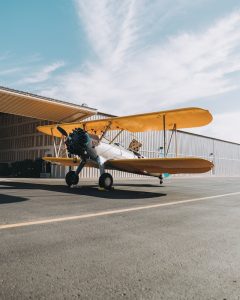
Landing gear is an essential component of all airplanes. Located in the undercarriage, it consists of wheels, cables, bakes and other parts that allow airplanes to safely move on the runway. Whether they are taking off or landing, pilots must leverage the airplane’s landing gear. Here are five facts about landing gear.
#1) Conventional and Tricycle Types
There’s conventional landing gear, and there’s tricycle landing gear. Conventional landing gear is characterized by the use of two large wheels at the front of the airplane and a smaller third wheel near the rear of the airplane.
Tricycle landing gear features three wheels as well, but they are placed in different areas. With tricycle landing gear, there are two large wheels under the wing. The third, smaller wheel, conversely is placed directly below the nose. Most wheel-based landing gear systems use either a conventional or tricycle setup such as this.
#2) May Be Used for Braking
Landing gear isn’t used exclusively on the runway. Depending on the specific type, pilots may use it for braking. They essentially act as speed brakes. Pilots can engage the airplane’s landing gear during flight to achieve a slower speed.
#3) Not All Landing Gear Features Wheels
When most people think of landing gear, they envision wheels. After all, wheels are a common part of most airplane landing gear systems. Without wheels, airplanes can’t be taxied on runways, nor can they take off or land at runways. But there are certain types of landing gear systems that don’t feature wheels.
Ski-based landing gear systems feature skis instead of wheels. Float-based landing gear systems feature floatation pontoons instead of wheels. These alternative types of landing gear systems are designed for use on snow or water, respectively.
#4) Military Airplanes May Use Tandem Landing Gear
While civilian and commercial airplanes typically use either conventional or tricycle landing gear, military airplanes may use a different type of landing gear: tandem. Tandem landing gear involves the use of a main front wheel and a smaller rear wheel, both of which are aligned on the longitudinal axis of the airplane. Tandem landing gear is designed to minimize drag, making it preferable for certain military airplanes.
#5) Landing Gear May Feature Extenders
Some landing gear systems feature extenders. They are available for both conventional and tricycle landing gear. Extenders are devices that, as the name suggests, extend the landing gear systems with which they are used. More specifically, they move the landing gears’ wheels forward by a few inches. If a pilot brakes too heavily, extenders can compensate by moving the wheels forward.



